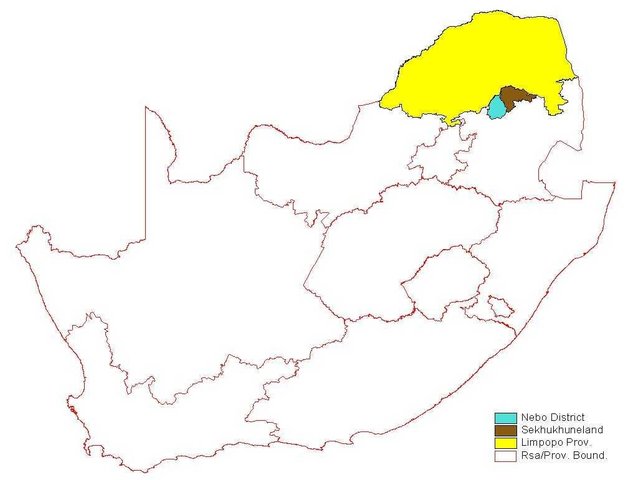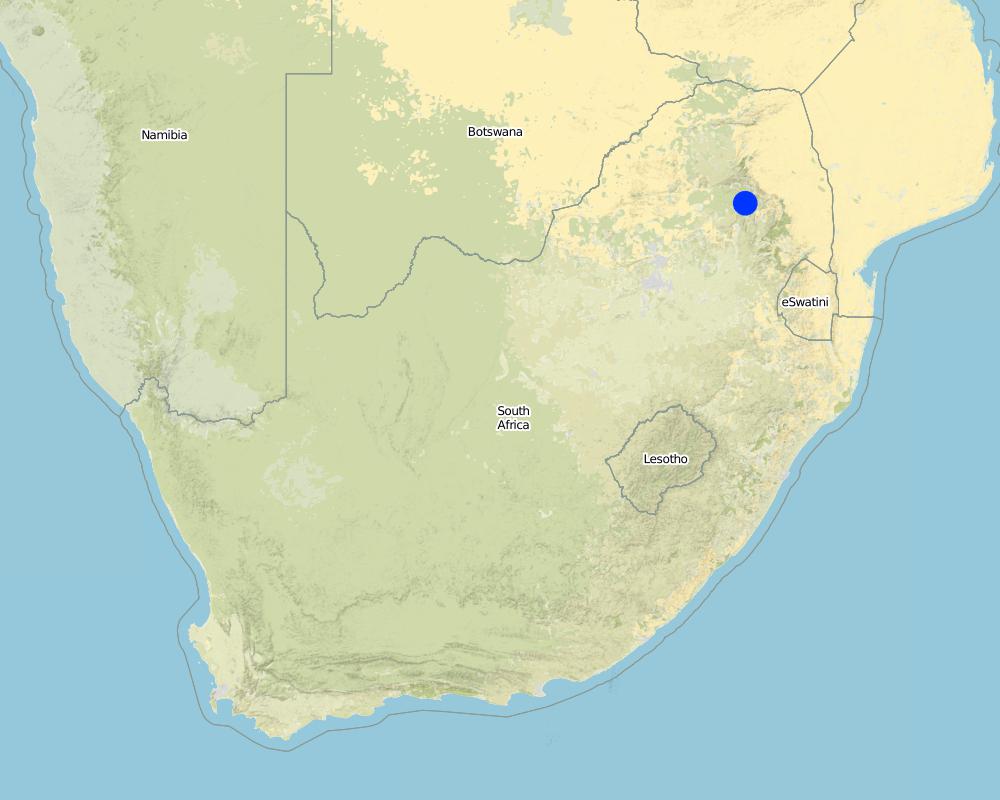Gully control (gabions) at Maandagshoek [南非]
- 创建:
- 更新:
- 编制者: Igmé Wilhelm Terblanche
- 编辑者: –
- 审查者: David Streiff, Alexandra Gavilano
Donga control, Maandagshoek Soil Conservation Project
technologies_1378 - 南非
查看章节
全部展开 全部收起1. 一般信息
1.2 参与该技术评估和文件编制的资源人员和机构的联系方式
有助于对技术进行记录/评估的机构名称(如相关)
Action Green Heritage (Action Green Heritage) - 南非1.3 关于使用通过WOCAT记录的数据的条件
编制者和关键资源人员接受有关使用通过WOCAT记录数据的条件。:
是
1.5 参考关于SLM方法(使用WOCAT记录的SLM方法)的调查问卷

Interactive community approach, biodiversity increase. [南非]
Community involvement
- 编制者: Igmé Wilhelm Terblanche
2. SLM技术的说明
2.1 技术简介
技术定义:
Stone walls and re-vegetation (planting of indigenous trees) = Rehabilitation
2.2 技术的详细说明
说明:
For the pilot project loose stones and sometimes concrete walls that work well were used. It is not more expensive than gabions, because a trucker is needed for gabions and it is labour intensive. Wire is also often stolen off the gabions.
The following steps were followed in this technology:
The areas are fenced, barricades (gabion like structure) erected, and planting done. Rehabilitation and environmental education was the overall purpose. Severe erosion dongas can be improved and used for controlled grazing.
The request came from the Communities, they would like to make money and make land available for Nature reserves (it is seen as a status symbol). Hunting by professional hunters and meat for biltong. The excess game goes to hunting (local) and the meat is sold to the community at a lower price. Very little poaching or damage to the fences occurs.
Looking after the fences, roads, gabions and water points (infrastructure) are all part of the maintenance. The Nature reserves are actually surrounded by villages, but there are no problems of people going into the Reserves.
The areas are classified as Nature Reserve - Savannah woodlands (Acock’s veld type: 19), Nebo - transitional zone between 61 and 18 (Acock’s veld type 61) and Sekhukuhne as mixed bushveld (Acock’s 19).
2.5 已应用该技术的、本评估所涵盖的国家/地区/地点
国家:
南非
区域/州/省:
Limpopo Province
有关地点的进一步说明:
Nebo District, Sekhukhuneland
具体说明该技术的分布:
- 均匀地分布在一个区域
如果不知道精确的区域,请注明大致覆盖的区域:
- 10-100 平方千米
注释:
Total area covered by the SLM Technology is Nebo Distr km2.
Former homeland area, communal grazing. SWC technology could also be applied outside of the Nature reserves. Big part of the Northern Province is similar to this area.
Map
×2.6 实施日期
如果不知道确切的年份,请说明大概的日期:
- 不到10年前(最近)
2.7 技术介绍
详细说明该技术是如何引入的:
- 通过项目/外部干预
3. SLM技术的分类
3.1 该技术的主要目的
- 保护生态系统
3.2 应用该技术的当前土地利用类型

牧场
粗放式放牧:
- 经营牧场
- game
注释:
Major land use problems (compiler’s opinion): Overpopulation (big pressure on veld), poor veld management (overgrazing), poor people. Population density most important factor.
Major land use problems (land users’ perception): Not enough land, or water for basic needs, agricultural development. Infrastructure was in place in 1964, Government did a lot of training, but there is not much left of anything.
Before the new Government (from 1990) things went downhill. People unsure about their future.
Ranching: Game
Grazingland comments: Trend towards ecotourism, more positive reaction to it.
Type of grazing system comments: Trend towards ecotourism, more positive reaction to it.
Number of growing seasons per year: 1
Longest growing period in days: 150; Longest growing period from month to month: Oct - Feb
3.5 该技术所属的SLM组
- nature conservancy system
3.6 包含该技术的可持续土地管理措施

农艺措施

植物措施

管理措施
注释:
Main measures: management measures
Secondary measures: vegetative measures, structural measures
Type of vegetative measures: scattered / dispersed
3.7 该技术强调的主要土地退化类型

土壤水蚀
- Wt:表土流失/地表侵蚀
- Wg:冲沟侵蚀/沟蚀

水质恶化
- Ha:干旱化
注释:
Secondary types of degradation addressed: Wt: loss of topsoil / surface erosion, Ha: aridification
Main causes of degradation: overgrazing, other human induced causes (specify) (Agricultural causes - Poor land-use practice), poverty / wealth (Lack of captial)
Secondary causes of degradation: deforestation / removal of natural vegetation (incl. forest fires), over-exploitation of vegetation for domestic use, other natural causes (avalanches, volcanic eruptions, mud flows, highly susceptible natural resources, extreme topography, etc.) specify (Soil types, especially in the eastern areas), education, access to knowledge and support services (Lack of knowledge), Lack of enforcement of legislat./authority (Becoming a bigger problem (is already a problem))
3.8 防止、减少或恢复土地退化
具体数量名该技术与土地退化有关的目标:
- 修复/恢复严重退化的土地
注释:
Secondary goals: prevention of land degradation, mitigation / reduction of land degradation
4. 技术规范、实施活动、投入和成本
4.1 该技术的技术图纸
技术规范(与技术图纸相关):
Technical knowledge required for field staff / advisors: low
Technical knowledge required for land users: low
Main technical functions: improvement of ground cover, sediment retention / trapping, sediment harvesting
Secondary technical functions: reduction of slope angle
Scattered / dispersed
Vegetative material: T : trees / shrubs
Number of plants per (ha): 150
Trees/ shrubs species: Tree species: adapt technology – no soil. Bigger holes, cattle manure (local available) and mixed
Other species: Botusantes speciosus, Peltophorum africanum Mainly this two species, also some Figus ingens
Structural measure: gabion
Construction material (stone): Started with big one and made it smaller (job creation)
Change of land use practices / intensity level: Fencing the area off
4.2 有关投入和成本计算的一般信息
其它/国家货币(具体说明):
Rand
如相关,注明美元与当地货币的汇率(例如1美元=79.9巴西雷亚尔):1美元=:
6.0
注明雇用劳工的每日平均工资成本:
3.50
4.3 技术建立活动
| 活动 | 时间(季度) | |
|---|---|---|
| 1. | Dig a hole | |
| 2. | Plant the seedling | |
| 3. | Watering | |
| 4. | Collecting stones | Before rainy season |
| 5. | For concrete structures, fix it on the side (dig in) | |
| 6. | Fencing the area off | |
| 7. | Reintroducing of game (Government paid for this) |
4.4 技术建立所需要的费用和投入
| 对投入进行具体说明 | 单位 | 数量 | 单位成本 | 每项投入的总成本 | 土地使用者承担的成本% | |
|---|---|---|---|---|---|---|
| 劳动力 | Construction of gabions and planting | ha | 1.0 | 3100.0 | 3100.0 | |
| 设备 | Machine use | ha | 1.0 | 210.0 | 210.0 | |
| 植物材料 | Tree seedlings | ha | 1.0 | 625.0 | 625.0 | |
| 施工材料 | Fencing | ha | 1.0 | 210.0 | 210.0 | |
| 技术建立所需总成本 | 4145.0 | |||||
| 技术建立总成本,美元 | 690.83 | |||||
注释:
Duration of establishment phase: 36 month(s)
4.5 维护/经常性活动
| 活动 | 时间/频率 | |
|---|---|---|
| 1. | Watering | For some months / |
| 2. | Bring loose stones back after very heavy storms | Rainy season/Once a year |
4.6 维护/经常性活动所需要的费用和投入(每年)
注释:
5ha, concrete was used; land was given by the community, it was not possible to use it for something else (before rehabilitation); in other cases government paid 100% for the nature reserve and the pilot project
4.7 影响成本的最重要因素
描述影响成本的最决定性因素:
Got funding only for a part of the area for one year. Then in the next year more funding, but never sure if enough funding will be available.
5 ha at Chuniespoort more expensive (concrete walls used). The costs for the community are the given land they couldn’t used for grazing anymore.
5. 自然和人文环境
5.1 气候
年降雨量
- < 250毫米
- 251-500毫米
- 501-750毫米
- 751-1,000毫米
- 1,001-1,500毫米
- 1,501-2,000毫米
- 2,001-3,000毫米
- 3,001-4,000毫米
- > 4,000毫米
农业气候带
- 半干旱
5.2 地形
平均坡度:
- 水平(0-2%)
- 缓降(3-5%)
- 平缓(6-10%)
- 滚坡(11-15%)
- 崎岖(16-30%)
- 陡峭(31-60%)
- 非常陡峭(>60%)
地形:
- 高原/平原
- 山脊
- 山坡
- 山地斜坡
- 麓坡
- 谷底
垂直分布带:
- 0-100 m a.s.l.
- 101-500 m a.s.l.
- 501-1,000 m a.s.l.
- 1,001-1,500 m a.s.l.
- 1,501-2,000 m a.s.l.
- 2,001-2,500 m a.s.l.
- 2,501-3,000 m a.s.l.
- 3,001-4,000 m a.s.l.
- > 4,000 m a.s.l.
关于地形的注释和进一步规范:
Slopes on average: Gentle for Potlake and rolling for Nebo
5.3 土壤
平均土层深度:
- 非常浅(0-20厘米)
- 浅(21-50厘米)
- 中等深度(51-80厘米)
- 深(81-120厘米)
- 非常深(> 120厘米)
土壤质地(表土):
- 粗粒/轻(砂质)
- 中粒(壤土、粉土)
表土有机质:
- 中(1-3%)
- 低(<1%)
如有可能,附上完整的土壤描述或具体说明可用的信息,例如土壤类型、土壤酸碱度、阳离子交换能力、氮、盐度等。:
Soil depth on average: Very shallow in Mantrombi, except behind the gabion and deep in Nebo
Soil texture: Coarse especially behind gabion
Soil fertility is low for Mantrombi, except silt deposit and medium for the rest
Topsoil organic matter is low for Mantrombi, but improving and medium for the rest
Soil drainage / infiltration is good
Soil water storage capacity is low for Maandagshoek, medium for Potlake and good for Nebo
5.6 应用该技术的土地使用者的特征
生产系统的市场定位:
- 商业/市场
非农收入:
- 收入的10-50%
相对财富水平:
- 非常贫瘠
- 贫瘠
说明土地使用者的其他有关特征:
Population density: 200-500 persons/km2
Annual population growth: 2% - 3%
(shop owners, doctors, etc).
40% of the land users are poor and own 40% of the land.
60% of the land users are poor and own 60% of the land.
Off-farm income specification: Working people are in towns, people who are living in the rural areas are children, women, and old people.
Market orientation of production system: Trends towards ecotourisme, more positive reaction to it. Game meat always popular, and becoming more regularly available to community. If it is available, they will go for it. Set area apart.
5.8 土地所有权、土地使用权和水使用权
土地所有权:
- 社区/村庄
土地使用权:
- 社区(有组织)
6. 影响和结论性说明
6.1 该技术的现场影响
社会经济效应
生产
饲料生产
注释/具体说明:
Mantrombi
饲料质量
注释/具体说明:
Mantrombi
木材生产
注释/具体说明:
Potlake
生产区域
注释/具体说明:
Not used for domestic livestock
收入和成本
农业收入
注释/具体说明:
Game meat
其它社会经济效应
thatch grass
注释/具体说明:
Mantrombi
社会文化影响
娱乐机会
注释/具体说明:
Convince people of department, that something is possible to work in black areas
社区机构
国家机构
SLM/土地退化知识
注释/具体说明:
Bigger awareness through Olifants River Forum
Environmental education
生态影响
水循环/径流
多余水的排放
土壤
土壤水分
土壤覆盖层
土壤流失
其它生态影响
biodiversity
6.2 该技术的场外影响已经显现
下游淤积
注释/具体说明:
In principal significant
地下水/河流污染
6.4 成本效益分析
技术收益与技术建立成本相比如何(从土地使用者的角度看)?
短期回报:
积极
长期回报:
非常积极
技术收益与技术维护成本/经常性成本相比如何(从土地使用者的角度看)?
短期回报:
轻度消极
长期回报:
轻度消极
6.7 该技术的优点/长处/机会
| 土地使用者眼中的长处/优势/机会 |
|---|
| Nature Reserves a possible income |
| 编制者或其他关键资源人员认为的长处/优势/机会 |
|---|
| Reduce siltation for whole catchment (dam build in 1965 silted up in ±20 years!) |
| For recovery of vegetation and made wasteland available again for grazing |
| Retain water for aquifer and household uses. |
| Nature Reserves: Increase in biodiversity & income for community. |
6.8 技术的弱点/缺点/风险及其克服方法
| 编制者或其他关键资源人员认为的弱点/缺点/风险 | 如何克服它们? |
|---|---|
| High cost for fencing etc. | |
| Soil conservation project – temporarily loss of land |
7. 参考和链接
7.1 信息的方法/来源
链接和模块
全部展开 全部收起链接

Interactive community approach, biodiversity increase. [南非]
Community involvement
- 编制者: Igmé Wilhelm Terblanche
模块
无模块


